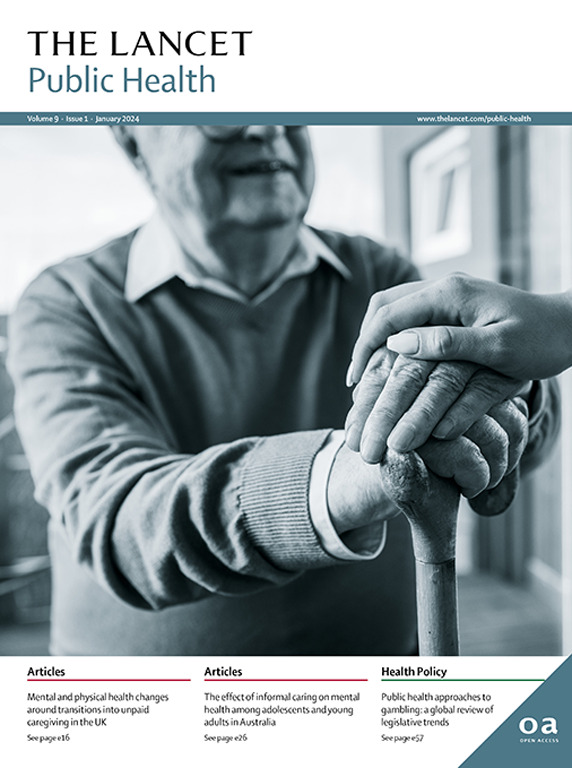The burden of bacterial antimicrobial resistance in the WHO Eastern Mediterranean Region 1990–2021: a cross-country systematic analysis with forecasts to 2050
IF 25.2
1区 医学
Q1 PUBLIC, ENVIRONMENTAL & OCCUPATIONAL HEALTH
引用次数: 0
Abstract
Background
Antimicrobial resistance (AMR) is an urgent global crisis and one of the world's most complex challenges. Although there is increasing evidence of its impact on human mortality and morbidity, precise burden estimation has many challenges, and thus far has been elusive for the Eastern Mediterranean Region. Here, we present a comprehensive time-trend analysis of regional and country-level AMR burden estimates in the WHO Eastern Mediterranean Region (EMR), between 1990 and 2021, with forecasts up to 2050.Methods
We estimated deaths and disability-adjusted life-years (DALYs) attributable to and associated with AMR for 11 infectious syndromes, 22 bacterial pathogens, and 84 pathogen–drug combinations for the WHO EMR and each of its countries from 1990 to 2021. Data were obtained from mortality registries, surveillance systems, hospital records, systematic literature reviews, and other sources. We based our modelling approach on five broad components: the number of deaths in which infection had a role, the proportion of infectious deaths attributable to a given infectious syndrome, the proportion of infectious syndrome deaths attributable to a given pathogen, the percentage of a given pathogen resistant to an antimicrobial drug of interest, and the excess risk of mortality (or duration of an infection) associated with this resistance. These components were then used to estimate the disease burden by using two counterfactual scenarios: deaths and DALYs attributable to AMR (considering an alternative scenario where drug-resistant infections are replaced with susceptible infections), and deaths and DALYs associated with AMR (considering an alternative scenario where infections would not occur at all). Predictive statistical modelling was applied to generate estimates of AMR burden for each country. We also generated AMR burden forecasts up to 2050. We generated 95% uncertainty intervals (UIs) for the final estimates by taking the 2·5th and 97·5th percentiles across 500 draws through the multistage computational pipeline, and models were cross-validated for out-of-sample predictive validity.Findings
We estimated 380 000 deaths (95% UI 332 000–426 000) associated with bacterial AMR and 92 800 deaths (78 300–111 000) attributable to bacterial AMR in the EMR in 2021. In the past 31 years, there was considerable variation in AMR mortality trends across countries of the region and different age groups. Between 1990 and 2021, associated deaths among children younger than 5 years decreased by 50·0% (38·2–62·0), while those among adults aged 70 and older rose by over 85·7% (95% UI 57·0–115·7). Six pathogens were identified as the primary generators of burden: Streptococcus pneumoniae, Klebsiella pneumoniae, Escherichia coli, Staphylococcus aureus, Acinetobacter baumannii, and Pseudomonas aeruginosa. A substantial increase in the AMR burden due to S aureus was observed between 1990 (28 200 deaths [21 600–34 000]) and 2021 (49 500 deaths [43 100–56 200]); consequently, in 2021, methicillin-resistant S aureus was a leading pathogen–drug combination for most countries in the region for deaths and DALYs attributable to, and associated with AMR. Somalia had the highest age-standardised mortality rates in the region: for deaths attributable to and associated with AMR per 100 000 population in both 1990 and 2021; conversely, the country with the lowest burden in the EMR was Qatar. By 2050, the number of deaths attributable to AMR in region is forecasted to reach 187 000 (157 000–223 000) and deaths associated with AMR were projected to reach 752 000 (629 000–879 000).Interpretation
Our study shows that bacterial AMR has been a serious public health threat in the EMR for more than 30 years, with a substantial fatal and non-fatal burden for priority bacterial pathogens and pathogen–drug combinations. The magnitude of this issue, future projects, and the inadequate response capacity in many countries underscore the need for more stringent regional leadership in this field. The insights gained from this study can direct targeted mitigation strategies for individual countries within the region, aiding in resource allocation and funding decisions, and emphasising the need for collaborative multisectoral endeavours among nations to address this issue.Funding
Wellcome Trust, and the UK Department of Health and Social Care using aid funding managed by the Fleming Fund.1990-2021年世卫组织东地中海区域细菌抗微生物药物耐药性负担:一项到2050年预测的跨国系统分析
抗生素耐药性(AMR)是一个紧迫的全球危机,也是世界上最复杂的挑战之一。虽然有越来越多的证据表明它对人类死亡率和发病率的影响,但精确的负担估计有许多挑战,迄今为止东地中海区域一直难以做到这一点。在此,我们对世卫组织东地中海区域(EMR) 1990年至2021年期间的区域和国家一级抗菌素耐药性负担估计数进行了全面的时间趋势分析,并预测到2050年。方法:我们估计了1990年至2021年WHO EMR及其每个国家11种感染综合征、22种细菌性病原体和84种病原体-药物组合中与AMR相关的死亡和伤残调整生命年(DALYs)。数据来自死亡登记、监测系统、医院记录、系统文献综述和其他来源。我们的建模方法基于五个广泛的组成部分:感染造成的死亡人数、归因于特定感染综合征的感染死亡比例、归因于特定病原体的感染综合征死亡比例、对感兴趣的抗菌药物具有耐药性的特定病原体的百分比,以及与这种耐药性相关的过量死亡风险(或感染持续时间)。然后使用这些组成部分通过使用两种反事实情景来估计疾病负担:抗菌素耐药性导致的死亡和DALYs(考虑到耐药感染被易感感染取代的替代情景),以及与抗菌素耐药性相关的死亡和DALYs(考虑到根本不会发生感染的替代情景)。采用预测统计模型对每个国家的抗菌素耐药性负担进行估算。我们还预测了到2050年的抗菌素耐药性负担。通过多级计算管道,我们在500次抽取中取2.5%和97.5%的百分位数,为最终估计生成了95%的不确定性区间(ui),并对模型进行了样本外预测有效性的交叉验证。研究结果:我们估计,2021年EMR中有38万例死亡(95% UI为332000 - 426000)与细菌AMR相关,92 800例死亡(78 300 - 111000)归因于细菌AMR。在过去31年中,该区域各国和不同年龄组的抗菌素耐药性死亡率趋势存在相当大的差异。1990年至2021年期间,5岁以下儿童的相关死亡率下降了50.0%(38.2 - 60.2),而70岁及以上成年人的相关死亡率上升了85.7%以上(95% UI为57.0 - 11.7)。确定了六种主要病原体:肺炎链球菌、肺炎克雷伯菌、大肠埃希菌、金黄色葡萄球菌、鲍曼不动杆菌和铜绿假单胞菌。在1990年(28 200例死亡[21 600-34 000例])和2021年(49 500例死亡[43 100-56 200例])期间,观察到金黄色葡萄球菌造成的抗菌素耐药性负担大幅增加;因此,在2021年,耐甲氧西林金黄色葡萄球菌是该区域大多数国家可归因于并与抗菌素耐药性相关的死亡和伤残赔偿金的主要病原体-药物组合。索马里是该区域年龄标准化死亡率最高的国家:1990年和2021年,每10万人中因抗微生物药物耐药性导致和与之相关的死亡人数;相反,EMR负担最低的国家是卡塔尔。到2050年,该区域因抗菌素耐药性导致的死亡人数预计将达到18.7万(15.7万至22.3万),与抗菌素耐药性相关的死亡人数预计将达到752万(62.9万至87.9万)。我们的研究表明,30多年来,细菌AMR一直是EMR中一个严重的公共卫生威胁,对重点细菌病原体和病原体-药物组合具有重大的致命和非致命负担。这一问题的严重性、未来的项目以及许多国家应对能力不足,都突出表明需要在这一领域建立更严格的区域领导。从这项研究中获得的见解可以指导本区域内个别国家的有针对性的缓解战略,有助于资源分配和供资决策,并强调需要各国之间开展多部门合作,努力解决这一问题。使用弗莱明基金管理的援助资金资助威康信托基金和英国卫生和社会保障部。
本文章由计算机程序翻译,如有差异,请以英文原文为准。
求助全文
约1分钟内获得全文
求助全文
来源期刊

Lancet Public Health
Medicine-Public Health, Environmental and Occupational Health
CiteScore
55.60
自引率
0.80%
发文量
305
审稿时长
8 weeks
期刊介绍:
The Lancet Public Health is committed to tackling the most pressing issues across all aspects of public health. We have a strong commitment to using science to improve health equity and social justice. In line with the values and vision of The Lancet, we take a broad and inclusive approach to public health and are interested in interdisciplinary research.
We publish a range of content types that can advance public health policies and outcomes. These include Articles, Review, Comment, and Correspondence. Learn more about the types of papers we publish.
 求助内容:
求助内容: 应助结果提醒方式:
应助结果提醒方式:


